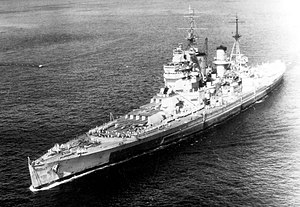King George V-class battleship (1939)

HMS King George V in 1945
|
|
| Class overview | |
|---|---|
| Name: | King George V-class battleship |
| Operators: |
|
| Preceded by: | Nelson class |
| Succeeded by: |
|
| Cost: | £7,393,134 |
| In commission: | 1940–51 |
| Completed: | 5 |
| Lost: | 1 |
| Scrapped: | 4 |
| General characteristics | |
| Class and type: | King George V-class battleship |
| Displacement: | 42,245 long tons (42,923 t) deep load |
| Length: |
|
| Beam: | 103 ft 2.5 in (31.5 m) |
| Draught: | 33 ft 7.5 in (10.2 m) |
| Installed power: | 110,000 shp (82,000 kW) |
| Propulsion: | |
| Speed: | 28.3 knots (52.4 km/h; 32.6 mph) |
| Range: | 15,600 nmi (28,900 km; 18,000 mi) at 10 knots (19 km/h; 12 mph) |
| Complement: | 1422 (1941) |
| Sensors and processing systems: |
|
| Armament: |
|
| Armour: |
|
| Aircraft carried: | 4 × Supermarine Walrus seaplanes |
| Aviation facilities: | 1 × double-ended catapult (removed early 1944) |
The King George V-class battleships were the most modern British battleships in commission during World War II. Five ships of this class were built: HMS King George V (1940), HMS Prince of Wales (1941), HMS Duke of York (1941), HMS Howe (1942) and HMS Anson (1942).
The Washington Naval Treaty of 1922 limited all of the number, displacement, and armament of warships built following its ratification, and this was extended by the First London Naval Treaty but these treaties were due to expire in 1936. With increased tension between Britain, the United States, Japan, France and Italy, it was supposed by the designers of these battleships that the treaty might not be renewed and the ships of the King George V class were designed with this possibility in mind.
All five ships saw combat during World War II, with King George V and Prince of Wales being involved in the action on 24 May to 27 May that resulted in the German battleship Bismarck being sunk. Following this on 25 October 1941, Prince of Wales was sent to Singapore arriving on 2 December and becoming the flagship of Force Z. On 10 December, Prince of Wales was attacked by Japanese bombers and sank with the loss of 327 of its men. In the aftermath of the sinking, King George V, Duke of York, Howe and Anson provided escort duty to convoys bound for Russia. On 1 May 1942, King George V collided with the destroyer HMS Punjabi, resulting in King George V being sent to Gladstone docks for repairs on 9 May, before returning to escort duty on 1 July 1942. On October 1942 Duke of York was sent to Gibraltar as the new flagship of Force H and supported the Allied landings in North Africa in November. Anson and Howe would also provide cover for multiple convoys bound for Russia from late 1942 until 1 March 1943, when Howe provided convoy cover for the last time. In May 1943 King George V and Howe were moved to Gibraltar in preparation for Operation Husky. The two ships bombarded Trapani naval base and Favignana on 11–12 July and also provided cover for Operation Avalanche on 7 September to 14 September. During this time Duke of York and Anson participated in Operation Gearbox, which was designed to draw attention away from Operation Husky. Duke of York was also heavily involved in the action that sank the German battleship Scharnhorst on 25 December 1943. This battle was also the last time that British and German capital ships fought each other.
...
Wikipedia
